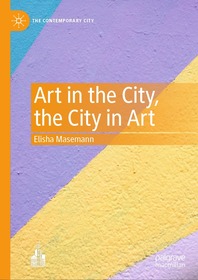
Art in the City, the City in Art
Series: The Contemporary City;
- Publisher's listprice EUR 139.09
-
57 687 Ft (54 940 Ft + 5% VAT)
The price is estimated because at the time of ordering we do not know what conversion rates will apply to HUF / product currency when the book arrives. In case HUF is weaker, the price increases slightly, in case HUF is stronger, the price goes lower slightly.
- Discount 20% (cc. 11 537 Ft off)
- Discounted price 46 150 Ft (43 952 Ft + 5% VAT)
Subcribe now and take benefit of a favourable price.
Subscribe
57 687 Ft

Availability
printed on demand
Why don't you give exact delivery time?
Delivery time is estimated on our previous experiences. We give estimations only, because we order from outside Hungary, and the delivery time mainly depends on how quickly the publisher supplies the book. Faster or slower deliveries both happen, but we do our best to supply as quickly as possible.
Product details:
- Edition number 2024
- Publisher Springer Nature Singapore
- Date of Publication 1 April 2024
- Number of Volumes 1 pieces, Book
- ISBN 9789819960415
- Binding Hardback
- No. of pages259 pages
- Size 210x148 mm
- Language English
- Illustrations XVI, 259 p. 12 illus., 10 illus. in color. Illustrations, black & white 550
Categories
Long description:
This Book examines an interplay between discourses on the city that stress the
need for rational-functional order and art’s imaginative deviations from the topdown
structures of urban life. Moving between theory and praxis, the book
situates the city as both a concept and physical construct through which lives and
possibilities are shaped or defined. In response, certain modalities of art create
spontaneous, non-rational and playful interludes that risk escape from the urban
apparatus and a hyper-valorisation of rational order. A three-part framework is
used to discuss this push-pull dynamic and to assess the strategies of shock,
performative embodiment and intervention that emerged in post-war art
movements and in contemporary performance and participatory art practices.
The book examines how the disturbances introduced by artists throw the city
construct into sharp relief, making it visible and activating momentary encounters
where new modes of expression can emerge.
This Book offers a new approach to interdisciplinary studies of art and urbanity.
The book aims to delineate how the city—as concept and construct—is made
visible through artistic practice and in turn challenged or interrogated. Students,
researchers and professionals with an interest in the interaction between art and
urban studies will discover a new perspective on how urban conditions and issues
have been addressed through artistic practice. The book contributes to an
evolving discourse in the urban humanities through an exposition of the city’s
default construct that is made visible or reimagined through visual art in public
spaces.
More
Table of Contents:
Chapter 1: Establishing the city’s ‘ground rules’.- Part I: Hardware.- Chapter 2: A rational city programme.- Chapter 3:Critical responses to the ‘city plan’.- Chapter 4: Art’s non-rational uses of the city.- Part II: Software.- Chapter 5: Ideology and the city.- Chapter 6: The body and the city.- Chapter 7: The everyday city.- Chapter 8: Disrupting ‘normalcy’ through art.- Part III: Networks.- Chapter 9: Networks that create control in the city.- Chapter 10: Foundations for cognitive dissonance.- Chapter 11: Art’s intervention in the society of control.- Chapter 12: Epilogue: An ongoing struggle between ‘art in the city, the city in art’.




